Spotlight Archive
An atheist, President Dwight Eisenhower once said, is a guy who watches a Notre Dame–SMU football game and doesn’t care who wins.
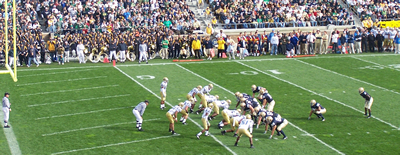 American Catholic identity is no longer as tied to the fortunes of the Fighting Irish football team as it was in the 1950s, but Notre Dame retains its status as a program with one of the largest followings in the nation—in part because of the loyalty of Catholics around the country who may have no connection to the school other than religion.
American Catholic identity is no longer as tied to the fortunes of the Fighting Irish football team as it was in the 1950s, but Notre Dame retains its status as a program with one of the largest followings in the nation—in part because of the loyalty of Catholics around the country who may have no connection to the school other than religion.
The history of Notre Dame football is thus not merely the history of a storied program filled with memorable coaches, players, and plays. It is also one dimension of the cultural history of American Catholicism.
Intercollegiate football at Notre Dame began on November 23, 1887, when the Irish lost to Michigan 8–0, inaugurating one of the oldest and fiercest rivalries in college football. The loss notwithstanding, the campus paper’s account of the game reported, “This occasion has started an enthusiastic football boom, and it is hoped that coming years will witness a series of these contests.”
In the last decade of the nineteenth century, the team won more often than not, laying the foundation for the success that would come after college football achieved greater organization and status with the formation of the Intercollegiate Athletic Association of the United States (later the NCAA) in 1906. After Notre Dame beat Michigan in 1909, the Wolverines refused to play the Irish for 33 years, the ostensible reason being the questionable academic eligibility of Notre Dame’s players. Notre Dame officials blamed the disagreement, as well as the refusal of the new Big Nine Conference of the upper Midwest to permit Notre Dame’s entry, on religious bigotry. In 1924, Notre Dame would again be turned away by what had become the Big Ten.
Under its first professional coach, Jess Harper, the Notre Dame team began building its legendary reputation. The pivotal moment was November 1, 1913, when the Irish beat perennial powerhouse Army with a revolutionary use of the forward pass. Performed in front of the major eastern press writers, the feat’s significance was amplified across the nation. “American Catholic pride in this single athletic victory was unbounded,” historian Robert Burns argues. “In an afternoon the university had acquired intense emotional commitments from a whole generation of Catholic working-class supporters and defenders that would endure for years.”
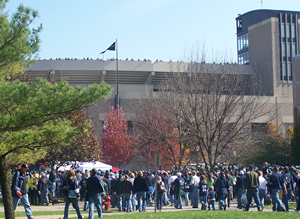 In 1918, Notre Dame hired as head coach one of the players from that team—the son of Norwegian Lutherans and a chemistry major, Knute Rockne. Rockne would coach until 1930, amassing a record of 105–12–5 and collecting six national championships. His winning percentage (.881) is the highest in the history of college football. The following created by his teams’ success spurred the construction in 1930 of Notre Dame Stadium—”the house that Rockne built.” Rockne managed every aspect of the football program and was singularly responsible for turning it into a gigantic enterprise. The 1919 team played nine games before a total of 56,500 spectators.
In 1918, Notre Dame hired as head coach one of the players from that team—the son of Norwegian Lutherans and a chemistry major, Knute Rockne. Rockne would coach until 1930, amassing a record of 105–12–5 and collecting six national championships. His winning percentage (.881) is the highest in the history of college football. The following created by his teams’ success spurred the construction in 1930 of Notre Dame Stadium—”the house that Rockne built.” Rockne managed every aspect of the football program and was singularly responsible for turning it into a gigantic enterprise. The 1919 team played nine games before a total of 56,500 spectators. 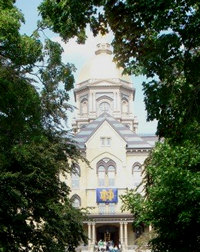 The 1929 team played the same number of games with a total attendance of 550,000. The extraordinary profitability of the football program did more than fund stadium-building; it was a key factor in the development of the University of Notre Dame as the premier American Catholic institution of higher education.
The 1929 team played the same number of games with a total attendance of 550,000. The extraordinary profitability of the football program did more than fund stadium-building; it was a key factor in the development of the University of Notre Dame as the premier American Catholic institution of higher education.
The 1920s were also the apex of anti-Catholicism in the United States, when a reorganized and rejuvenated Ku Klux Klan gained massive popularity throughout the Midwest. In this context, the Notre Dame team took on additional cultural significance. “The national prominence of Knute Rockne’s teams from an obscure and penurious Catholic school in one of the most Protestant states of the Union,” historian Mark Massa writes, “became a source of both pride and group esteem for millions of American Catholics who never set foot on the campus.” According to the university’s prefect of religion (and future cardinal) Father John O’Hara, CSC, the 1924 season was “looked upon by the players as a kind of spiritual crusade.” The religious significance of on-field competition was reflected in a South Bend Tribune headline, “Notre Dame defeats Wabash, 34–0, Presbyterians Helpless before Attack.” University prestige and Catholic pride overflowed during a triumphant Rose Bowl tour across the country at the end of that year.
Not all Catholics jumped on the bandwagon. English professor George Shuster wrote editorials in America and Commonweal in 1925, decrying the low state of American Catholic intellectual life and insinuating that colleges’ focus on football was one source of the problem. At many other American universities, the perceived conflict between academics and athletics would gradually be eliminated by focusing on one to the forthright neglect of the other. Notre Dame administrators insisted that excellence in both areas could be attained, but tension between the two aims persisted.
Rockne coached many legendary players, including the “Four Horsemen”—Harry Stuhldreher, Don Miller, Jim Crowley, and Elmer Layden—and George Gipp. Ronald Reagan played Gipp in Hollywood’s version of the coach’s life, Knute Rockne—All-American. Gipp’s mythical significance at Notre Dame may be gauged by the fact that the major historical treatment of the university devotes twenty pages to this single athlete. On November 10, 1928, the underdog Irish, inspired by their coach’s “Win one for the Gipper” speech, beat undefeated Army.
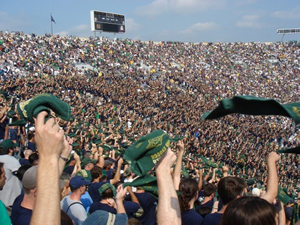 The 1929 and 1930 championship teams were led by a pair of halfbacks, Marty Brill and Marchmont Schwartz, the latter of whom was Jewish, but that did not prevent the American hierarchy from reading Catholic triumph into the team’s accomplishments. Bishop Noll of Fort Wayne, accompanying the team during their 1930 trip to the West Coast where they beat Southern California, boasted that he knew the players would be victorious, going all out “for their alma mater, for Rockne, and for the glory of the Church.” University administrators were under constant pressure from bishops to obtain prized game seats for the prelates and their favored friends.
The 1929 and 1930 championship teams were led by a pair of halfbacks, Marty Brill and Marchmont Schwartz, the latter of whom was Jewish, but that did not prevent the American hierarchy from reading Catholic triumph into the team’s accomplishments. Bishop Noll of Fort Wayne, accompanying the team during their 1930 trip to the West Coast where they beat Southern California, boasted that he knew the players would be victorious, going all out “for their alma mater, for Rockne, and for the glory of the Church.” University administrators were under constant pressure from bishops to obtain prized game seats for the prelates and their favored friends.
After the USC victory assured the national title, the team boarded the train for South Bend. Robert Burns describes the scene: “Catholics of all degrees of religious attachment showed their appreciation for what the team had done for their pride and self-esteem by turning out en masse at railroad stations along the route from Los Angeles to Chicago to cheer their heroes homeward.” In March of the following year, Knute Rockne died when the airplane in which he was traveling crashed in Kansas.
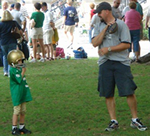 Rockne was soon followed by another enormously successful coach, Frank Leahy. His teams (1941–1943, 1946–1953) won four national championships and went undefeated six times. The team continued to carry the weight of American Catholics’ aspirations. Parochial school students of the 1950s remember their teaching nuns leading them in prayer on Fridays during the football season—prayer for Irish victory that weekend. Ethnic, working-class Catholics “saw in the Notre Dame players their own sons,” sportswriter Mike Celizic claimed.
Rockne was soon followed by another enormously successful coach, Frank Leahy. His teams (1941–1943, 1946–1953) won four national championships and went undefeated six times. The team continued to carry the weight of American Catholics’ aspirations. Parochial school students of the 1950s remember their teaching nuns leading them in prayer on Fridays during the football season—prayer for Irish victory that weekend. Ethnic, working-class Catholics “saw in the Notre Dame players their own sons,” sportswriter Mike Celizic claimed.
Hauling this kind of cultural freight, Notre Dame football could also become a venue for internal Catholic disputes. The followers of Father Leonard Feeney of Boston, who espoused a strict interpretation of the phrase extra ecclesiam nulla salus (“outside the Church, no salvation”), used football games as protest sites. “The first sign of your approaching damnation,” barked one demonstrator who ran onto the field in 1953, “is that Notre Dame has Protestants on its football team.”
Though Paul Hornung became the fifth Irish player to win the Heisman Trophy in 1956, the later 1950s and early sixties represented a nadir in Notre Dame football fortunes. A bright spot was November 15, 1957, when the team traveled to Oklahoma to take on the Sooners, winners of forty-seven consecutive games. On game day, at Mass in a small town outside Norman, Monty Stickles recalled, the players were met by a group of grade-school children: “They were begging us to win so they could have bragging rights against the Baptists. It was kind of a ‘win one for the Catholics’ thing.” Notre Dame won, 7–0.
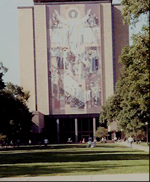 In 1963, the fourteen-story Theodore Hesburgh Library was built at the north end of Notre Dame Stadium. A giant mural of Christ with arms raised adorned the south side of the new building. Adjacent to one of the stadium's end zones, the art acquired an irresistible if irreverent moniker: “Touchdown Jesus.”
In 1963, the fourteen-story Theodore Hesburgh Library was built at the north end of Notre Dame Stadium. A giant mural of Christ with arms raised adorned the south side of the new building. Adjacent to one of the stadium's end zones, the art acquired an irresistible if irreverent moniker: “Touchdown Jesus.”
The 1963 team under Hugh Devore went 2–7. But 1964 marked the beginning of the Ara Parseghian era (1964–1974). The second non-Catholic coach in Notre Dame history, his teams went 95–17–4 with two national championships and three major bowl wins.
Despite Parseghian’s triumphs, perhaps the most memorable moment of his tenure was his hotly debated decision to play for a tie against number 2-ranked Michigan State game of 1966. Jim Murray of the Los Angeles Times expressed the dismay of Notre Dame partisans in the headline of his report on the game, “’Tis a Pity When the Irish ‘Tie One for the Gipper.’”
Success continued under Parseghian’s successor Dan Devine (1975–1980), who coached one more national championship team. That was 1978, when Notre Dame upset first longtime rival USC and then No. 1 Texas in the Cotton Bowl, on the strength of the arm of “Comeback Joe” Montana. Devine’s tenure also saw Irish football again furnish material for Hollywood, with the 1975 story of Daniel Ruettiger rendered on-screen as Rudy (1993).
After a mediocre interlude, winning resumed under Lou Holtz (1986–1996), whose teams went 100–30–2 and captured another national championship in 1989.
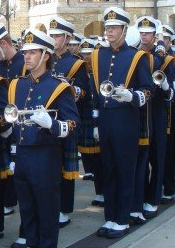 Though the developments of American Catholic history have weakened the identity between Catholics’ status and Notre Dame football success, the Catholic flavor of Irish football remains unmistakable. Players still attend Mass together before processing through the throngs of fans toward the stadium, accompanied by the oldest collegiate marching band in the country, which dates to the 1887 Michigan contest. “Notre Dame football weekends are tightly scripted extravaganzas ... ,” observes theology professor Father Thomas O’Meara, OP, “designed by people with an attachment to sacramental rituals.” Followers of Notre Dame football, Joe Garner writes, are linked not by geography but by “spirituality and a history that’s woven into each of its nooks and crannies ... into its songs and its memories.”
Though the developments of American Catholic history have weakened the identity between Catholics’ status and Notre Dame football success, the Catholic flavor of Irish football remains unmistakable. Players still attend Mass together before processing through the throngs of fans toward the stadium, accompanied by the oldest collegiate marching band in the country, which dates to the 1887 Michigan contest. “Notre Dame football weekends are tightly scripted extravaganzas ... ,” observes theology professor Father Thomas O’Meara, OP, “designed by people with an attachment to sacramental rituals.” Followers of Notre Dame football, Joe Garner writes, are linked not by geography but by “spirituality and a history that’s woven into each of its nooks and crannies ... into its songs and its memories.”
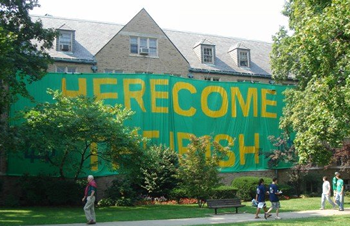 The history of Notre Dame football is so legendary that the online journal of satire, The Onion, once . And Notre Dame rivalries extend beyond the gridiron to the telling of history itself. New Republic journalist Jonathan Chait attacked the mythic character of Irish football in an op-ed in September, 2006. A letter to the editor in the LA Times chided Chait and noted that “having gone to Michigan, he probably didn’t get much of an education.”
The history of Notre Dame football is so legendary that the online journal of satire, The Onion, once . And Notre Dame rivalries extend beyond the gridiron to the telling of history itself. New Republic journalist Jonathan Chait attacked the mythic character of Irish football in an op-ed in September, 2006. A letter to the editor in the LA Times chided Chait and noted that “having gone to Michigan, he probably didn’t get much of an education.”
Photos courtesy of Anna Franzonello and Chris Sokol © 2006 CatholicHistory.net
Posted November 2006. Error corrected June 2008.
Sources and Further Reading
